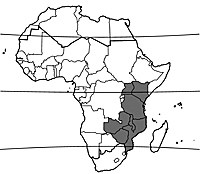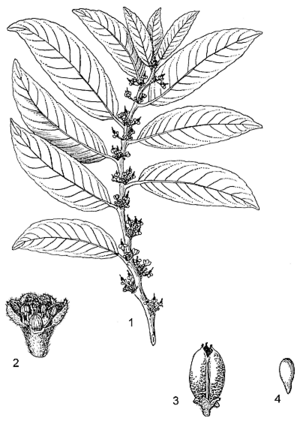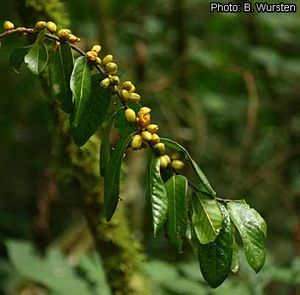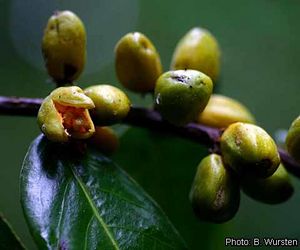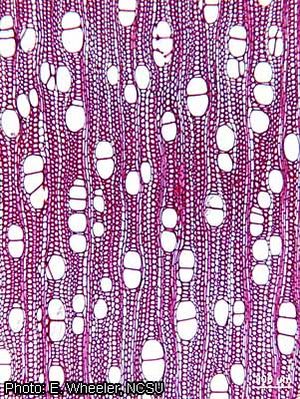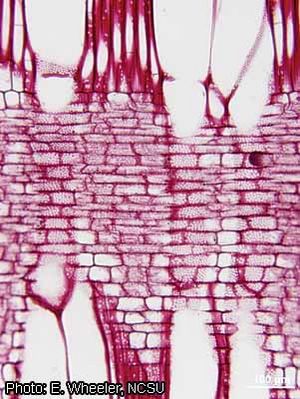Casearia battiscombei (PROTA)
Introduction |
| General importance | |
| Geographic coverage Africa | |
| Geographic coverage World | |
| Medicinal | |
| Timber | |
| Fuel | |
| Auxiliary plant | |
| Fibre | |
Casearia battiscombei R.E.Fr.
- Protologue: Notizbl. Bot. Gart. Berlin-Dahlem 9: 326 (1925).
- Family: Flacourtiaceae (APG: Salicaceae)
Vernacular names
- Forest sword-leaf (En).
Origin and geographic distribution
Casearia battiscombei occurs from Kenya and Uganda southward to Zimbabwe and Mozambique.
Uses
The wood (known in Kenya as ‘casearia’ or ‘muirungi’ and in Tanzania as ‘white matua’) is commonly used for joinery, interior trim and furniture. It is suitable for vehicle bodies, boxes, crates, turnery, veneer and plywood, and as pulpwood for paper production. It is also used as firewood and for charcoal production. In Mozambique the roots are used to treat malaria.
Production and international trade
The wood of Casearia battiscombei has no importance in the international trade. It is mainly used locally.
Properties
The heartwood is restricted to a narrow dark brown core, sapwood very wide, whitish to pale yellow-brown, sometimes with reddish streaks. The grain is straight, texture fine and even. Freshly sawn wood has an unpleasant smell which disappears upon drying.
The wood is medium-weight, with a density of 515–750 kg/m³ at 12% moisture content, soft and brittle. It air dries moderately fast, with a slight tendency to distortion and warping. The wood is very susceptible to blue staining, and therefore rapid drying of freshly sawn wood is advised. For kiln drying, low temperatures are recommended. The rates of shrinkage are moderate, from green to 12% moisture content 1.9% radial and 4.9% tangential.
At 12% moisture content, the modulus of rupture is 81 N/mm², modulus of elasticity 10,290 N/mm², compression parallel to grain 46 N/mm², shear 12.5 N/mm² and Janka side hardness 3205 N.
The wood saws and works well with both hand and machine tools. Planing is satisfactory with back-sawn material, but quarter-sawn material is liable to tearing. The wood polishes well and takes a satisfacory finish. It holds nails well. Boring is less favourable and should be done with support to avoid splitting. The bending properties are rather poor. The wood is not durable, being susceptible to termite, Lyctus and marine borer attacks. The sapwood is permeable and can be easily treated with preservatives using either open-tank or pressure-vacuum systems. Wood dust may cause irritation of mucous membranes in wood workers.
Description
- Small to fairly large tree up to 40 m tall; bole cylindrical, straight, branchless for up to 21 m, up to 50(–110) cm in diameter, often slightly buttressed; bark surface smooth, becoming scaly and rough in older trees, pale greyish to brownish, inner bark orange-brown; crown rounded, with spreading or slightly drooping branches arranged in tiers; young twigs short-hairy, soon becoming glabrous.
- Leaves alternate, simple; stipules triangular, up to 2 mm long, caducous; petiole 0.5–1(–1.5) cm long; blade oblong to elliptical, 8–22 cm × 3–6(–7) cm, asymmetrically cuneate to rounded at base, obtuse to acuminate at apex, margin entire to wavy, sometimes slightly and irregularly toothed, glabrous but with pellucid dots, pinnately veined with 10–20 pairs of lateral veins.
- Inflorescence an axillary fascicle, many-flowered.
- Flowers bisexual, regular, yellowish green; pedicel 3–4 mm long, up to 1 cm in fruit; receptacle funnel-shaped, c. 2 mm long; sepals 5, broadly elliptical to round, c. 2 mm long, short-hairy to nearly glabrous; petals absent; stamens 6–10, c. 1 mm long, alternating with hairy staminodes c. 0.5 mm long; ovary superior, ovoid, glabrous, 1-celled, with very short style and head-shaped stigma.
- Fruit an ellipsoid to ovoid capsule 1–2 cm × 0.5–1 cm, slightly angular, pointed at apex, glabrous, yellowish to orange when ripe, dehiscing from above with 2–4 valves, few-seeded.
- Seeds ellipsoid to obovoid, c. 0.5 cm long, smooth and pale, almost completely enclosed in a fleshy whitish aril becoming reddish upon exposure.
Other botanical information
Casearia comprises about 180 species and occurs in all tropical and subtropical regions. In tropical Africa approximately 15 species can be found, most of them in mainland Africa and a few in Madagascar and the Mascarene islands.
Casearia engleri
Casearia engleri Gilg is a medium-sized tree up to 20 m tall, endemic to the West Usambara Mountains in Tanzania, where it plays a role in agro-ecosystems. Its wood, which seems to be quite similar to that of Casearia battiscombei, is used for poles and as firewood. Casearia engleri is listed as vulnerable in the IUCN Red List.
Casearia gladiiformis
Casearia gladiiformis Mast. is a large shrub or small tree up to 15(–20) m tall, occurring from Kenya south to South Africa. Its wood, which is similar to that of Casearia battiscombei, is suitable for joinery and furniture. Bark ash is used as snuff, and in Tanzania a root decoction is taken to enhance conception.
Casearia nigrescens
Casearia nigrescens Tul. is a large shrub or small tree up to 15(–20) m tall, endemic to Madagascar, where it is widespread. It is variable and has been considered to represent several distinct species. Its soft but elastic wood is used for joinery and musical instruments. Leaf and bark decoctions are considered to relieve pain and are an ingredient of mixtures taken by women as a tonic. Leaf and bark extracts were found to be cytotoxic in a human ovarian cancer cell line; the clerodane diterpene casearlucin L was isolated as most active compound.
Anatomy
Wood-anatomical description (IAWA hardwood codes):
- Growth rings: 2: growth ring boundaries indistinct or absent.
- Vessels: 5: wood diffuse-porous; (12: solitary vessel outline angular); 13: simple perforation plates; 22: intervessel pits alternate; 25: intervessel pits small (4–7 μm); 30: vessel-ray pits with distinct borders; similar to intervessel pits in size and shape throughout the ray cell; 31: vessel-ray pits with much reduced borders to apparently simple: pits rounded or angular; 42: mean tangential diameter of vessel lumina 100–200 μm; 48: 20–40 vessels per square millimetre.
- Tracheids and fibres: 61: fibres with simple to minutely bordered pits; 65: septate fibres present; 69: fibres thin- to thick-walled; (70: fibres very thick-walled).
- Axial parenchyma: 75: axial parenchyma absent or extremely rare.
- Rays: 97: ray width 1–3 cells; 102: ray height > 1 mm; 108: body ray cells procumbent with over 4 rows of upright and/or square marginal cells; 109: rays with procumbent, square and upright cells mixed throughout the ray; 113: disjunctive ray parenchyma cell walls present; 116: ≥ 12 rays per mm.
- Mineral inclusions: 136: prismatic crystals present; 137: prismatic crystals in upright and/or square ray cells; (144: druses present); (145: druses in ray parenchyma cells); (148: druses in chambered cells).
Growth and development
In southern Africa Casearia battiscombei flowers in October and fruits ripen about 3 months later. The seed arils are probably eaten by animals, which may serve as seed dispersers.
Ecology
Casearia battiscombei is most common in high rainfall areas in highlands, where it is found in moist forest and forest margins, at 1000–2500 m altitude.
Propagation and planting
The 1000-seed weight is about 21 g.
Management
In general the density of Casearia battiscombei trees in the forest is quite variable; it is locally still abundant, e.g. in South Nandi Forest in Kenya where more than 5 boles of more than 20 cm in diameter occur per ha, and near Arusha in Tanzania, but it is dwindling in other areas due to excessive logging.
Harvesting
Trees are harvested by the selective logging system. Caution should be taken during harvesting operations because logs may be brittle. Large logs may have heart rot, whereas star shakes are common.
Handling after harvest
Freshly felled logs should be rapidly removed from the forest and processed because the wood is very susceptible to blue-stain attack.
Genetic resources
Casearia battiscombei is locally common within its fairly large geographical range and its exploitation is moderate, and it is therefore unlikely to be threatened by genetic erosion at present. However, in several regions it has been recorded as rare (especially in southern Africa, e.g. in Zimbabwe) or dwindling in forests where it was formerly abundant (especially in East Africa). Monitoring of populations is therefore recommended.
Prospects
Casearia battiscombei is a useful source of wood for purposes where durability is not required. Although very little is known about growth rates and suitable silvicultural and management practices, it is one of the emerging preferred species within its geographical range and it could have a high potential. Research is warranted to give recommendations for sustainable management in the natural forest.
Major references
- Bolza, E. & Keating, W.G., 1972. African timbers: the properties, uses and characteristics of 700 species. Division of Building Research, CSIRO, Melbourne, Australia. 710 pp.
- Bryce, J.M., 1967. The commercial timbers of Tanzania. Tanzania Forest Division, Utilisation Section, Moshi, Tanzania. 139 pp.
- Chikamai, B.N., Githiomi, J.K., Gachathi, F.N. & Njenga, M.G., undated. Commercial timber resources of Kenya. Kenya Forestry Research Institute (KEFRI), Nairobi, Kenya. 164 pp.
- Chudnoff, M., 1980. Tropical timbers of the world. USDA Forest Service, Agricultural Handbook No 607, Washington D.C., United States. 826 pp.
- Coates Palgrave, K., 1983. Trees of southern Africa. 2nd Edition. Struik Publishers, Cape Town, South Africa. 959 pp.
- Maundu, P. & Tengnäs, B. (Editors), 2005. Useful trees and shrubs for Kenya. World Agroforestry Centre - East and Central Africa Regional Programme (ICRAF-ECA), Technical Handbook 35, Nairobi, Kenya. 484 pp.
- Takahashi, A., 1978. Compilation of data on the mechanical properties of foreign woods (part 3) Africa. Shimane University, Matsue, Japan. 248 pp.
- Wimbush, S.H., 1957. Catalogue of Kenya timbers. 2nd reprint. Government Printer, Nairobi, Kenya. 74 pp.
Other references
- Arumadri, J., 2001. The forest revenue system and government expenditure on forestry in Uganda. Working paper on financing sustainable forest management: FSFM/WP/08, Food and Agriculture Organization of the United Nations, Rome.
- Beentje, H.J., 1994. Kenya trees, shrubs and lianas. National Museums of Kenya, Nairobi, Kenya. 722 pp.
- Boiteau, P., Boiteau, M. & Allorge-Boiteau, L., 1999. Dictionnaire des noms malgaches de végétaux. 4 Volumes + Index des noms scientifiques avec leurs équivalents malgaches. Editions Alzieu, Grenoble, France.
- Breteler, F.J., 2008. A synopsis of Casearia Jacq. (Samydeae – Salicaceae) in West and Central Africa with a description of a new species from Eastern Congo (Kinshasa). Kew Bulletin 63: 101–112.
- Fowler, D.G., 2006. Traditional fever remedies: a list of Zambian plants. 61 pp.
- Guza, R.C., 2004. Isolation of natural products from Casearia nigrescens. Msc thesis, Virginia Polytechnic Institute and State University, United States. 68 pp.
- Hyde, M.A. & Wursten, B., 2010. Casearia battiscombei. [Internet ] Flora of Mozambique. http://www.mozambiqueflora.com/ speciesdata/ species.php?species_id=140850. February 2010.
- Kitula, R.A., 2007. Use of medicinal plants for human health in Udzungwa Mountains Forests: a case study of New Dabaga Ulongambi Forest Reserve, Tanzania. Journal of Ethnobiology and Ethnomedicine 3: 7.
- Liu, K., Eastwood, R.J., Flynn, S., Turner, R.M. & Stuppy, W.H., 2008. Casearia battiscombei. [Internet] Seed Information Database Release 7.1, May 2008. http://www.kew.org/ data/sid/ sidservlet?id=36103&num=qrx. February 2010.
- Lovett, J. & Clarke, G.P., 1998. Casearia engleri. In: IUCN. Red list of threatened species. Version 2010.4. [Internet] http://www.iucnredlist.org December 2010.
- Lovett, J.C. & Pócs, T., 1993. Assessment of the condition of the Catchment Forest Reserves, a botanical appraisal. Catchment Forest Project Report 93. 3. Forest Division/NORAD, Dar es Salaam, Tanzania. pp. 105–146.
- Lovett, J.C., Ruffo, C.K., Gereau, R.E. & Taplin, J.R.D., 2006. Field guide to the moist forest trees of Tanzania. [Internet] Centre for Ecology Law and Policy, Environment Department, University of York, York, United Kingdom. http://celp.org.uk/ projects/ tzforeco/. December 2010.
- Munishi, P.K.T., Philipina, F., Temu, R.P.C. & Pima, N.E., 2008. Tree species composition and local use in agricultural landscapes of West Usambaras, Tanzania. African Journal of Ecology 46, Suppl. s1: 66–73.
- Rutamu, I., 1999. Low cost biodigesters for zero grazing smallholder dairy farmers in Tanzania. [Internet] Livestock Research for Rural Development 11(2). http://www.cipav.org.co/ lrrd/lrrd11/2/ mten112.htm. February 2010.
- Sleumer, H., 1971. Le genre Casearia Jacq. (Flacourtiaceae) en Afrique, à Madagascar et aux Mascareignes. Bulletin du Jardin Botanique National de Belgique 41: 397–426.
- Sleumer, H., 1975. Flacourtiaceae. In: Polhill, R.M. (Editor). Flora of Tropical East Africa. Crown Agents for Oversea Governments and Administrations, London, United Kingdom. 68 pp.
- Wild, H., 1960. Flacourtiaceae (incl. Samydaceae). In: Exell, A.W. & Wild, H. (Editors). Flora Zambesiaca. Volume 1, part 1. Crown Agents for Oversea Governments and Administrations, London, United Kingdom. pp. 261–298.
Sources of illustration
- Wild, H., 1960. Flacourtiaceae (incl. Samydaceae). In: Exell, A.W. & Wild, H. (Editors). Flora Zambesiaca. Volume 1, part 1. Crown Agents for Oversea Governments and Administrations, London, United Kingdom. pp. 261–298.
Author(s)
- E.A. Obeng, Forestry Research Institute of Ghana (FORIG), University P.O. Box 63, KNUST, Kumasi, Ghana
Correct citation of this article
Obeng, E.A., 2011. Casearia battiscombei R.E.Fr. [Internet] Record from PROTA4U. Lemmens, R.H.M.J., Louppe, D. & Oteng-Amoako, A.A. (Editors). PROTA (Plant Resources of Tropical Africa / Ressources végétales de l’Afrique tropicale), Wageningen, Netherlands. <http://www.prota4u.org/search.asp>.
Accessed 6 March 2025.
- See the Prota4U database.

